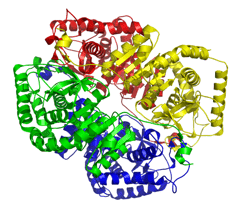
Wondering why LDH, or lactate dehydrogenase, release is a good measure of cytotoxicity? When treated with a cytotoxic compound, living cells may face one of two fates. They could either stop growing and dividing, or die through either of two distinct processes - necrosis or apoptosis. Basically, cells undergoing necrosis (accidental cell death) swell and lose membrane integrity before shutting down and releasing their intracellular contents into the surrounding environment. This type of cell death is usually triggered by external factors such as toxic chemical or traumatic physical events.
On the other hand, cells undergoing apoptosis (normal or programmed cell death) go through a series of well-defined events such as the shrinking of the cytoplasm, cleavage of DNA into smaller fragments, etc. before being engulfed by white blood cells.
When the cell membranes are compromised or damaged in any way, lactate dehydrogenase (LDH), a soluble yet stable enzyme found inside every living cell, is released into the surrounding extracellular space. Since this only happens when cell membrane integrity is compromised, the presence of this enzyme in the culture medium can be used as a cell death marker. The relative amounts of live and dead cells within the medium can then be quantitated by measuring the amount of released LDH using a colorimetric or fluorometric LDH cytotoxicity assay.
Other enzymes such as adenylate kinase and glucose-6-phosphate may also be used to measure cytotoxicity but these enzymes are not stable and lose their activity during cell death assays.
LDH Cytotoxicity Assay: Colorimetric
When using an LDH colorimetric assay, the amount of LDH released in the surrounding environment is measured with an enzymatic reaction which converts iodonitrotetrazolium or INT (a tetrazolium salt) into a red color formazan.
When LDH is present in the cell culture, it reduces NAD+ to NADH and H+ through the oxidation of lactate to pyruvate. Afterward, the catalyst (diaphorase) then transfers H/H+ from NADH + H+ to the tetrazolium salt INT to form the red colored formazan salt. The amount of color produced is measured at 490nm by standard spectroscopy and is proportional to the amount of damaged cells in the culture.
Due to the inherent linearity of this LDH cytotoxicity assay, it can be easily used to accurately determine the percentage of damaged or injured cells in a sample. In addition, its simplicity, reliability, and accuracy makes it an excellent alternative to 51Cr release cytotoxicity assays, a highly sensitive method that measures low levels of cytotoxicity by using radioactive isotopes.
The colorimetric LDH cytotoxicity assay can also be used with different cell types for assaying cell-mediated and chemical-mediated cytotoxicity and is ideal for cell-free supernatants from cells in culture.
LDH Cytotoxicity Assay: Fluorometric
When using an LDH fluorometric cytotoxicity assay, LDH converts lactate to pyruvate to produce NADH, which then converts resazurin, a non-fluorescent compound, to a fluorescent compound resorufin. This LDH cytotoxicity assay is capable of detecting low level damage to cell membrane which cannot detected using other methods. And since it does not damage healthy cells, the LDH cytotoxicity assay can be performed directly in the cell culture wells containing a mixed population of viable and damaged cells. The assay can be used to determine the number of non-viable cells in a mixed population of healthy and damaged cells, and may also be used to estimate the number of cells in a sample.
Note: Both colorimetric and fluorometric LDH assays can be used for the detection of cell toxicity, death, viability or proliferation, and are ideal for high throughput screening.
Other Cytotoxicity Assays
Aside from the LDH colorimetric and fluorometric assays, cytotoxicity can also be measured using sulforhodamine B (SRB) and WST assays.
SRB Assay
The SRB cytotoxicity assay is a simple, accurate and reproducible assay capable of measuring total biomass by staining cellular proteins with sulforhodamine B (SRB), an anionic aminoxanthene dye that forms an electrostatic complex with the basic amino acid residues of proteins under slightly acid conditions. The color development is rapid and stable, and absorbance is readily measured between 560 and 580nm using a microplate reader. This assay is commonly used for cell density determination, and can be used for high-throughput drug screening.
WST Assay
The WST assay is a highly sensitive and accurate assay used in determining cell proliferation and cytotoxicity. This assay is performed in a single cell tissue culture well and does not require any washing, harvesting or solubilization steps.
When using this method, adherent or suspension cells are cultured in a microplate, incubated with WST-1 (a highly sensitive tetrazolium salt), and monitored with a spectrophotometer. The action of cellular dehydrogenases reduces tetrazolium salt WST-1 to dark yellow colored formazan, which is then measured at 420 to 480nm (optimal at 440nm). The reading indicates the number of viable cells in the sample.
Image Source: Wikipedia






